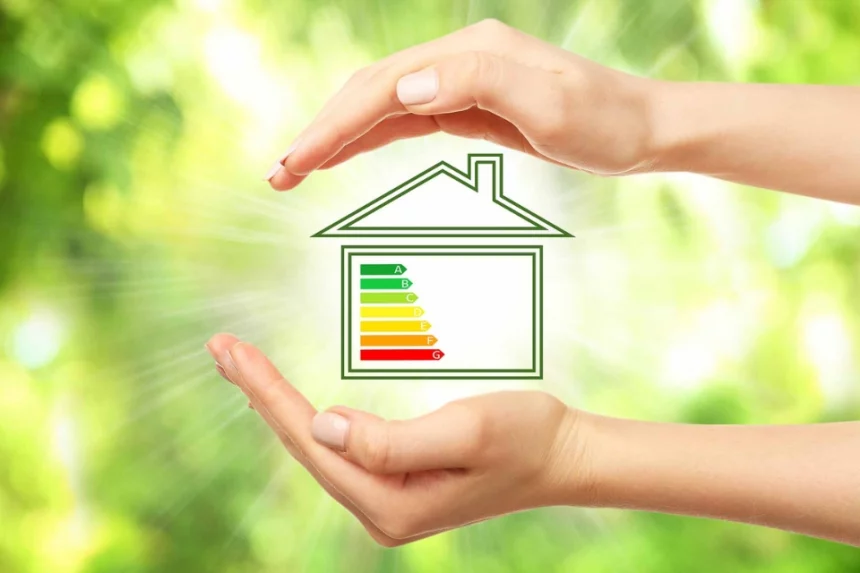Living in an energy-efficient home is a win-win situation. Not only does it help save money on utility bills, but it also contributes to a cleaner, greener environment. By making small changes to our daily routine and upgrading our home’s appliances and systems, we can make a significant difference in both our wallet and the environment. In this article, we’ll provide you with tips and tricks to make your home more energy-efficient, from simple changes you can make today to larger investments that will pay off in the long run. Whether you’re a homeowner or a renter, there are plenty of options available to make your home more sustainable. So, let’s dive in and explore the ways you can save money and the environment with an energy-efficient home.
What is an energy-efficient home?
An energy-efficient home is a house that has been designed and built to use less energy than a standard home. It is a home that uses energy-efficient appliances and systems, such as heating and cooling, lighting, and water heating. An energy-efficient home is not just about the appliances and systems; it is also about the design and construction of the home. An energy-efficient home is designed to maximize the use of natural light and ventilation, reduce heat loss, and prevent air leaks. A well-designed and well-built energy-efficient home can reduce energy consumption by up to 50%.
Benefits of having an energy-efficient home
There are several benefits of having an energy-efficient home, including:
1. Cost savings
One of the most significant benefits of having an energy-efficient home is cost savings. Energy-efficient homes use less energy, which translates to lower utility bills. The savings can be significant, especially in the long run.
2. Environmental benefits
An energy-efficient home reduces the amount of energy required to operate, which means fewer greenhouse gas emissions. Greenhouse gas emissions are one of the leading causes of climate change, so reducing them is crucial for the environment.
3. Increased comfort
Energy-efficient homes are designed to maximize comfort while minimizing energy consumption. They are better insulated, which means they stay warm in the winter and cool in the summer. They also have better ventilation, which means they have better air quality.
4. Increased home value
An energy-efficient home has a higher resale value than a standard home. Homebuyers are increasingly looking for energy-efficient homes, so having an energy-efficient home can make your home more attractive to potential buyers.
5. Reduced maintenance
Energy-efficient homes require less maintenance than standard homes. Energy-efficient appliances and systems tend to last longer, which means fewer repairs are required.
Energy-saving tips for your home
There are several simple changes you can make to your daily routine to make your home more energy-efficient:
1. Turn off lights and appliances when not in use
Turning off lights and appliances when not in use can save a significant amount of energy. It’s important to unplug appliances when not in use, as they can still use energy when plugged in.
2. Use energy-efficient light bulbs
Energy-efficient light bulbs use less energy than traditional incandescent bulbs. They last longer and produce less heat, which means they can save you money on cooling costs in the summer.
3. Use a programmable thermostat
A programmable thermostat allows you to set the temperature of your home based on your schedule. You can set it to lower the temperature when you’re away from home and raise it when you return. This can save you money on heating and cooling costs.
4. Seal air leaks
Air leaks can waste a significant amount of energy. Sealing air leaks around doors and windows can reduce energy consumption and improve comfort.
5. Use natural light
Using natural light instead of artificial light can save energy and improve your mood. Open your curtains during the day to let in natural light, and close them at night to keep the heat in.
Upgrading your home’s appliances and systems for energy efficiency
Upgrading your home’s appliances and systems can make a significant difference in energy consumption. Here are some upgrades to consider:
1. Energy-efficient appliances
Energy-efficient appliances, such as refrigerators, washing machines, and dishwashers, use less energy than standard appliances. They can save you money on utility bills in the long run.
2. Energy-efficient heating and cooling systems
Heating and cooling systems are one of the largest energy consumers in a home. Upgrading to an energy-efficient system can save you money on utility bills and improve comfort.
3. Energy-efficient water heaters
Water heating is another significant energy consumer in a home. Upgrading to an energy-efficient water heater can save you money on utility bills and reduce greenhouse gas emissions.
4. Energy-efficient windows and doors
Windows and doors are a significant source of energy loss in a home. Upgrading to energy-efficient windows and doors can improve comfort and reduce energy consumption.
5. Energy-efficient lighting
Upgrading to energy-efficient lighting, such as LED bulbs, can save you money on utility bills and reduce greenhouse gas emissions.
Investing in renewable energy sources for your home
Investing in renewable energy sources, such as solar or wind power, can make your home even more energy-efficient. Here are some options to consider:
1. Solar panels
Solar panels are a popular renewable energy source for homes. They can provide electricity for your home and reduce your reliance on the grid.
2. Wind turbines
Wind turbines are another renewable energy source that can provide electricity for your home. They are less common than solar panels, but they can be effective in windy areas.
3. Geothermal heating and cooling
Geothermal heating and cooling systems use the natural heat of the earth to heat and cool your home. They are energy-efficient and can save you money on utility bills.
4. Micro-hydro systems
Micro-hydro systems use running water to generate electricity. They are effective in areas with running water, such as streams or rivers.
5. Biomass heating
Biomass heating systems use organic matter, such as wood or plant matter, to heat your home. They are a renewable energy source and can be effective in rural areas.
Tax credits and rebates available for energy-efficient upgrades
There are several tax credits and rebates available for energy-efficient upgrades. These incentives can help offset the cost of upgrades and make them more affordable. Here are some examples:
1. Federal tax credits
The federal government offers tax credits for energy-efficient upgrades, such as solar panels and energy-efficient windows and doors.
2. State tax credits
Many states offer tax credits for energy-efficient upgrades. Check with your state’s energy office to see what incentives are available in your area.
3. Utility rebates
Many utility companies offer rebates for energy-efficient upgrades. These rebates can help offset the cost of upgrades and make them more affordable.
4. Manufacturer rebates
Some manufacturers offer rebates for energy-efficient appliances and systems. Check with the manufacturer to see what incentives are available.
5. Financing options
Many financing options are available for energy-efficient upgrades, such as low-interest loans and energy-efficient mortgages. These financing options can make upgrades more affordable.
DIY energy efficiency projects you can do at home
There are several DIY energy efficiency projects you can do at home. These projects are easy to do and can save you money on utility bills. Here are some examples:
1. Weatherstripping
Adding weatherstripping around doors and windows can reduce air leaks and improve comfort.
2. Insulation
Adding insulation to your home can reduce heat loss and improve comfort.
3. Window coverings
Adding window coverings, such as curtains or blinds, can reduce heat loss and improve comfort.
4. Low-flow showerheads
Replacing your showerhead with a low-flow option can save water and reduce energy consumption.
5. Power strips
Using power strips can help reduce standby power consumption by turning off appliances when not in use.
Hiring a professional for energy-efficient upgrades
While DIY projects can be effective, some energy-efficient upgrades require a professional. Hiring a professional can ensure that the upgrade is done correctly and safely. Here are some examples:
1. HVAC systems
Upgrading your heating and cooling system requires a professional. They can ensure that the system is installed correctly and safely.
2. Solar panels
Installing solar panels requires a professional. They can ensure that the panels are installed correctly and safely.
3. Energy audits
An energy audit can help identify areas of your home that can be improved for energy efficiency. A professional can perform an energy audit and provide recommendations.
4. Home performance upgrades
Home performance upgrades, such as air sealing and insulation, require a professional. They can ensure that the upgrades are done correctly and safely.
5. Building a new energy-efficient home
Building a new energy-efficient home requires a professional. They can ensure that the home is designed and built to maximize energy efficiency.
Sustainable home design and construction
Sustainable home design and construction are becoming increasingly popular. Sustainable homes are designed and built to maximize energy efficiency and minimize environmental impact. Here are some examples of sustainable home design and construction:
1. Passive solar design
Passive solar design uses the sun’s energy to heat and cool a home. It involves designing a home to maximize the use of natural light and ventilation.
2. Green roofs
Green roofs are roofs that are covered in vegetation. They help regulate temperature, reduce stormwater runoff, and improve air quality.
3. Recycled materials
Using recycled materials, such as reclaimed wood, can reduce the environmental impact of home construction.
4. Net-zero homes
Net-zero homes are homes that produce as much energy as they consume. They are designed and built to maximize energy efficiency and use renewable energy sources.
5. Tiny homes
Tiny homes are small, energy-efficient homes that are becoming increasingly popular. They are designed to maximize space and minimize energy consumption.
Conclusion: Taking action for an energy-efficient home
Living in an energy-efficient home is not only beneficial for your wallet but also for the environment. Making small changes to your daily routine and upgrading your home’s appliances and systems can make a significant difference in both. Whether you’re a homeowner or a renter, there are plenty of options available to make your home more sustainable. From simple changes you can make today to larger investments that will pay off in the long run, we hope this article has provided you with the information you need to take action for an energy-efficient home.



